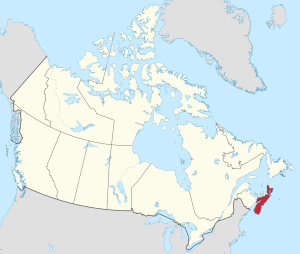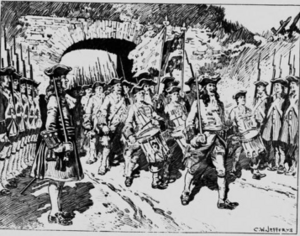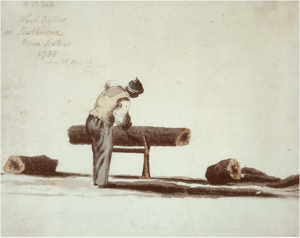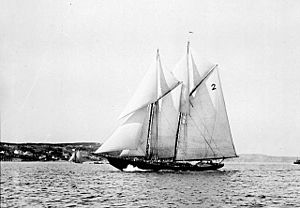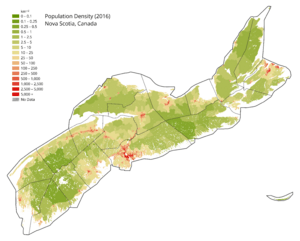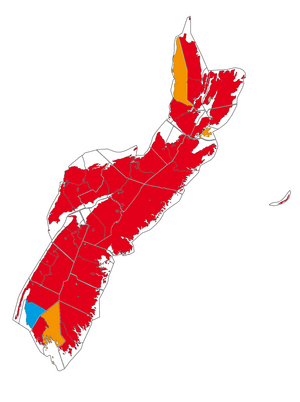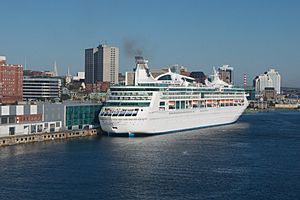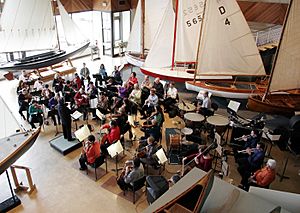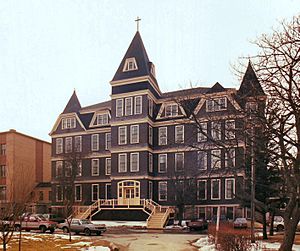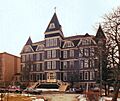Nova Scotia facts for kids
Quick facts for kids
Nova Scotia
|
|||
|---|---|---|---|
|
|||
| Motto(s): | |||
| Country | Canada | ||
| Confederation | 1 July 1867 (1st, with New Brunswick, Ontario, Quebec) | ||
| Capital | Halifax | ||
| Largest city | Halifax | ||
| Largest metro | Halifax | ||
| Government | |||
| • Type | Parliamentary constitutional monarchy | ||
| Area | |||
| • Total | 55,284 km2 (21,345 sq mi) | ||
| • Land | 52,942 km2 (20,441 sq mi) | ||
| • Water | 2,342 km2 (904 sq mi) 4.2% | ||
| Area rank | Ranked 12th | ||
| 0.6% of Canada | |||
| Population | |||
| • Total | 969,383 | ||
| • Estimate
(Q2 2024)
|
1,072,545 | ||
| • Rank | Ranked 7th | ||
| • Density | 18.31/km2 (47.4/sq mi) | ||
| Demonym(s) | Nova Scotian, Bluenoser | ||
| Official languages | Canadian English (de jure) First Language: Mi'kmawi'simk Recognized Regional Languages: Canadian French, Canadian Gaelic |
||
| GDP | |||
| • Rank | 7th | ||
| • Total (2020) | CA$46.849 billion | ||
| • Per capita | CA$52,390 (12th) | ||
| HDI | |||
| • HDI (2019) | 0.903 — Very high (11th) | ||
| Time zone | UTC-04:00 (Atlantic) | ||
| Postal abbr. |
NS
|
||
| Postal code prefix |
B
|
||
| ISO 3166 code | CA-NS | ||
| Flower | Mayflower | ||
| Tree | Red spruce | ||
| Bird | Osprey | ||
| Rankings include all provinces and territories | |||
Nova Scotia is a province in Canada, located on the country's east coast. It is one of the three Maritime provinces. The name "Nova Scotia" means "New Scotland" in Latin.
Nova Scotia is the most populated province in Atlantic Canada. As of 2024, it has over 1 million people. It is also the second most densely populated province in Canada. The province includes the Nova Scotia peninsula and Cape Breton Island, plus 3,800 other islands along the coast. Nova Scotia is connected to New Brunswick by a narrow strip of land called the Isthmus of Chignecto.
The capital and largest city is Halifax. More than 45% of the province's people live there. Halifax is the largest city in Atlantic Canada. It is also Canada's second-largest coastal city after Vancouver.
Before Europeans arrived, the Miꞌkmaq people lived in the land that is now Nova Scotia. In 1605, the French started their first colony in New France called Acadia. Its capital was Port Royal. For over a century, Britain and France fought for control of the area. Britain finally gained control in 1713 after the Peace of Utrecht. Later, the British brought in new settlers and forced many French-speaking Acadians to leave. During the American Revolutionary War (1775–1783), thousands of Loyalists (people loyal to Britain) moved to Nova Scotia.
In 1848, Nova Scotia became the first British colony to have its own responsible government. This meant its local government could make decisions for the colony. In July 1867, Nova Scotia joined Canadian Confederation with New Brunswick and the Province of Canada (now Ontario and Quebec). This created the country of Canada.
Contents
Exploring Nova Scotia's Geography
Nova Scotia is Canada's second-smallest province by land area, only larger than Prince Edward Island. It is surrounded by four large bodies of water: the Gulf of Saint Lawrence to the north, the Bay of Fundy to the west, the Gulf of Maine to the southwest, and the Atlantic Ocean to the east.
The main part of the province is the Nova Scotia peninsula. It has many bays and rivers that flow into the sea. No place in Nova Scotia is more than 67 kilometers (42 miles) from the ocean. Cape Breton Island, a large island to the northeast, is also part of the province. Sable Island, a small island known for shipwrecks, is about 175 kilometers (109 miles) off the southern coast.
Nova Scotia has many old rock formations that hold fossils. These fossils are especially common along the shores of the Bay of Fundy. Places like Joggins Fossil Cliffs have many fossils from the Carboniferous period. Wasson's Bluff has fossils from the Triassic and Jurassic periods. The highest point in Nova Scotia is White Hill, which is 533 meters (1,749 feet) above sea level. It is located in the Cape Breton Highlands.
Nova Scotia is located along the 45th parallel north. This means it is halfway between the Equator and the North Pole. The province also has 5,400 lakes.
Nova Scotia's Climate
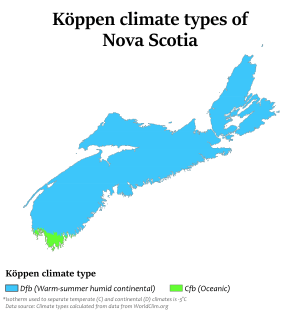
Nova Scotia is in a middle-temperature zone. Even though it is almost surrounded by water, its climate is more like a continental climate than a maritime one. The ocean helps to make the winter and summer temperatures less extreme. Winters are still cold enough to be called continental, but they are warmer than areas further inland.
The climate in Nova Scotia is similar to the central Baltic Sea coast in Northern Europe, but it gets more rain and snow.
| Location | July (°C) | July (°F) | January (°C) | January (°F) |
|---|---|---|---|---|
| Halifax | 23/14 | 73/58 | 0/−8 | 32/17 |
| Sydney | 23/12 | 73/54 | −1/−9 | 30/14 |
| Kentville | 25/14 | 78/57 | −1/−10 | 29/14 |
| Truro | 24/13 | 75/55 | −1/−12 | 29/9 |
| Liverpool | 25/14 | 77/57 | 0/–9 | 32/15 |
| Shelburne | 23/12 | 73/54 | 1/−8 | 33/17 |
| Yarmouth | 21/12 | 69/55 | 1/−7 | 33/19 |
A Look at Nova Scotia's History
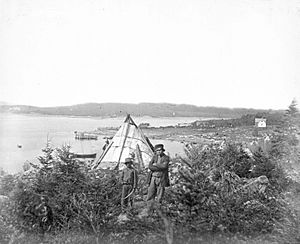
The Mi'kmaq people lived in Nova Scotia long before Europeans came. Their territory, called Mi'kma'ki, covered the Maritimes and other parts of eastern Canada. The Mi'kmaq are part of the Algonquian language family.
Early European Settlement
The first Europeans to settle in Nova Scotia were the French in 1604. In 1605, they built the first lasting European settlement in Canada at Port Royal. This area became known as Acadia. For about 150 years, most people in the colony were Catholic Mi'kmaq and Acadians.
There were many conflicts in Nova Scotia during the 17th and 18th centuries. The English, Scottish, Dutch, and French often fought for control of the region.
18th Century Changes
In 1710, the British took control of Port Royal, ending French rule in the Nova Scotia peninsula. The Peace of Utrecht treaty in 1713 officially gave this land to Britain. However, Cape Breton Island and Prince Edward Island remained French. After 1710, Nova Scotia was still mostly populated by Acadians and Mi'kmaq people. British forces were mainly in Annapolis and Canso. Port Royal was renamed Annapolis Royal after Queen Anne.
Conflicts continued between the Acadians, Mi'kmaq, French, and British. In 1749, Edward Cornwallis arrived to establish Halifax. This led to more fighting. The first local government assembly in Halifax met in 1758.
During the French and Indian War (1754–1763), the British forced many Acadians to leave. They brought in new settlers from New England. After the war, some Acadians were allowed to return.

In 1763, most of Acadia, including Cape Breton Island and New Brunswick, became part of Nova Scotia. However, Prince Edward Island became a separate colony in 1769.
The American Revolution (1775–1783) greatly changed Nova Scotia. At first, some people in Nova Scotia were unsure whether to join the revolution. But American privateers (armed ships) attacked Nova Scotian communities and ships. These attacks made many Nova Scotians support the British. By the end of the war, Nova Scotia had its own privateers attacking American ships.
After the American Revolution ended in 1781, about 33,000 Loyalists moved to Nova Scotia. They were given land by the British Crown. This migration created new towns like Shelburne. It also brought new money and skills to Nova Scotia. About 3,000 Black Loyalists also arrived, founding Birchtown, the largest free Black settlement in North America at the time.
19th Century Developments
During the War of 1812, Nova Scotian communities helped the British by buying or building privateer ships to attack U.S. vessels. A famous moment was when HMS Shannon brought the captured American ship USS Chesapeake into Halifax Harbour in 1813.
In 1848, Nova Scotia became the first British colony in North America to gain responsible government. This was thanks to the efforts of Joseph Howe. This meant the local government had more control over its own affairs.
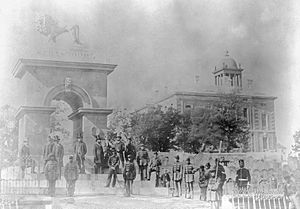
Nova Scotians also fought in the Crimean War (1853–1856). The Sebastopol Monument in Halifax, built in 1860, is the second-oldest war monument in Canada.
Thousands of Nova Scotians fought in the American Civil War (1861–1865), mostly for the North. Nova Scotia's economy grew during this time as it traded with both sides.
After Confederation
Soon after the American Civil War, Charles Tupper, the Premier of Nova Scotia, led the province to join Canadian Confederation on July 1, 1867. Nova Scotia joined with New Brunswick and the Province of Canada. However, many Nova Scotians, led by Joseph Howe, were against joining Confederation. In the election that followed, the Anti-Confederation Party won almost all the seats.
Throughout the 1800s, many important businesses started in Nova Scotia. These included the Starr Manufacturing Company (Canada's first ice skate maker), the Bank of Nova Scotia, and Cunard Line.
In the late 1800s, Nova Scotia became a world leader in building and owning wooden sailing ships. Famous shipbuilders like Donald McKay came from Nova Scotia. In 1895, Joshua Slocum became the first person to sail alone around the world. The racing schooner Bluenose continued this fame in the next century with its many victories.
In December 1917, about 2,000 people died in the Halifax Explosion, a huge disaster.
Nova Scotia's People and Languages
Population Growth
Ethnic Backgrounds
Based on the 2016 Canadian census, the largest ethnic groups in Nova Scotia are Scottish (30.0%), English (28.9%), and Irish (21.6%). Other groups include French (16.5%), German (10.7%), and First Nations (5.4%). Many people (42.6%) also identified their background as "Canadian."
Languages Spoken
English is the most common language spoken in Nova Scotia. According to the 2021 Canadian Census, 99.59% of people speak English. French is spoken by 10.39% of the population. Other languages spoken include Arabic, Hindi, Spanish, and Mandarin.
| Rank | Language | Population | Percentage |
|---|---|---|---|
| 1. | English | 868,365 | 89.57% |
| 2. | French | 34,675 | 3.57% |
| 3. | Arabic | 9,560 | 0.98% |
| 4. | Mandarin | 7,185 | 0.74% |
| 5. | Punjabi | 5,335 | 0.55% |
| 6. | Tagalog | 4,255 | 0.43% |
| 7. | Mi'kmaw | 3,990 | 0.41% |
| 8. | German | 3,480 | 0.35% |
| 9. | Spanish | 3,075 | 0.31% |
| 10. | Hindi | 3,020 | 0.31% |
Nova Scotia has the largest community of Scottish Gaelic speakers outside of Scotland. A small number of native speakers live in Pictou County, Antigonish County, and Cape Breton Island. The language is also taught in some high schools. In 2018, the government introduced a Gaelic vehicle license plate to help promote the language and culture.
Religious Beliefs
Based on the 2021 census, most people in Nova Scotia identify as Christian (58.2%). A large number of people (37.6%) do not identify with any religion. Other religious groups include Islam (1.5%), Hinduism (0.9%), and Sikhism (0.5%).
Nova Scotia's Economy
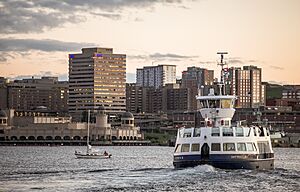
Nova Scotia's economy has grown slower than the rest of Canada in recent years. In 2016, the average income per person was lower than the national average.
The province is the world's largest exporter of Christmas trees, lobster, gypsum, and wild berries. It exports over $1 billion worth of fish products to 90 countries. However, Nova Scotia imports more goods than it exports.
Historically, Nova Scotia's economy relied on its natural resources, especially the rich fish stocks off the coast. Fishing was a major part of the economy since the 1600s. However, due to overfishing, the fishing industry declined sharply in the late 20th century. This led to about 20,000 job losses in 1992.
Other industries have also faced challenges. Coal mining in Cape Breton has mostly stopped, and a large steel mill in Sydney closed in the 1990s. The strong Canadian dollar has also hurt the forestry industry. Mining, especially for gypsum and salt, is still important. Since 1991, offshore oil and gas has been a key part of the economy, though production is now decreasing. However, farming is still important, especially in the Annapolis Valley.

Nova Scotia's defense and aerospace industry brings in about $500 million in revenue each year. About 40% of Canada's military assets are located in Nova Scotia. The province also has a growing Information & Communication Technology (ICT) sector with over 500 companies and about 15,000 employees.
Manufacturing is also a big part of the economy. Michelin is the largest private employer in the province, with three production plants.
Tourism in Nova Scotia
Nova Scotia's tourism industry has over 6,500 businesses and supports nearly 40,000 jobs. It brings about $1.3 billion to the economy each year. Cruise ships often visit the province. In 2010, the Port of Halifax welcomed 261,000 passengers.
Nova Scotia's tourism highlights its culture, beautiful scenery, and coastline. The province has many museums that show its history and different cultures. These include the Glooscap Heritage Centre, Grand-Pré National Historic Site, and the Black Cultural Centre for Nova Scotia. Other museums, like the Cape Breton Miners Museum, tell stories about its working history.
Nova Scotia is home to many famous musicians. There are visitor centers in the hometowns of Hank Snow, Rita MacNeil, and Anne Murray. The province also hosts many music and cultural festivals. Some popular ones are the Stan Rogers Folk Festival and Celtic Colours.
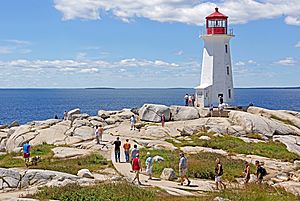
Nova Scotia has 87 National Historic Sites of Canada. These include the Habitation at Port-Royal and the Fortress of Louisbourg. The province also has two national parks, Kejimkujik and Cape Breton Highlands.
The Bay of Fundy has the highest tides in the world. The famous Peggys Cove lighthouse attracts over 600,000 visitors each year. Old Town Lunenburg is a port town that is a UNESCO World Heritage Site.
Acadian Skies and Mi'kmaq Lands is a special "starlight reserve" in southwestern Nova Scotia. It is the first certified UNESCO-Starlight Tourist Destination. These places are protected from light pollution, making them great for stargazing.
Nova Scotia's Culture
Local Cuisine
The food in Nova Scotia is typical Canadian, with a focus on fresh local seafood. One unique dish is the Halifax donair. It's made with thinly sliced beef and a sweet sauce. Another local dish is hodge podge, a creamy soup with fresh baby vegetables.
The province is also known for a dessert called blueberry grunt.
Events and Festivals
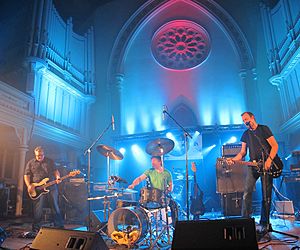
Nova Scotia hosts many fun festivals and cultural events throughout the year. Here are some of them:
- Annapolis Valley Apple Blossom Festival
- Atlantic Film Festival
- Celtic Colours
- Hal-Con
- Halifax Busker Festival
- Halifax Comedy Festival
- Halifax Jazz Festival
- Halifax Pop Explosion
- Halifax Pride
- Nova Scotia Gaelic Mod
- Pictou Lobster Carnival
- Royal Nova Scotia International Tattoo
- Stan Rogers Folk Festival
- Wharf Rat Rally
Film and Television in Nova Scotia
Nova Scotia has produced many talented film actors. Academy Award nominee Elliot Page (from Juno) was born in Halifax. Other actors from the province include John Paul Tremblay, Robb Wells, and Mike Smith from Trailer Park Boys.
Many movies have been filmed in Nova Scotia. Some famous ones include Titanic (starring Leonardo DiCaprio and Kate Winslet) and The Shipping News (starring Kevin Spacey).
Nova Scotia has also created many popular television series. These include This Hour Has 22 Minutes, Trailer Park Boys, and Theodore Tugboat.
Fine Arts Scene
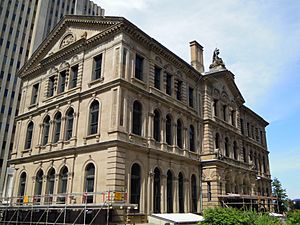
Halifax is home to important art institutions like the Nova Scotia College of Art and Design University and the Art Gallery of Nova Scotia. The province has a lively scene for visual art, traditional crafts, writing, and film.
Many historic public sculptures in Nova Scotia were made by famous artists like J. Massey Rhind and Hamilton MacCarthy. Nova Scotian artist John Wilson also created public art.
Some of Nova Scotia's greatest painters include Maud Lewis, Alex Colville, and marine artist John O'Brien. The Art Gallery of Nova Scotia has works by famous British artists like Joshua Reynolds.
Literature from Nova Scotia
Many Nova Scotian authors have become famous worldwide. These include Thomas Chandler Haliburton (who wrote The Clockmaker) and Alistair MacLeod (who wrote No Great Mischief).
Nova Scotia has also been the setting for many popular books. Some international best-sellers include Curse of the Narrows: The Halifax Explosion 1917 by Laura MacDonald. Famous authors like Henry Wadsworth Longfellow (who wrote the poem Evangeline) have also written about Nova Scotian stories.
Media and News
News in Nova Scotia
The first newspaper printed in Nova Scotia was the Halifax Gazette on March 23, 1752. It was also the first newspaper printed anywhere in Canada.
Today, the main daily newspaper is The Chronicle Herald, which started in 1874. It is the most widely read newspaper in Atlantic Canada. The Nova Scotia Government also has an online archive of old newspapers.
Radio Stations
The first radio station in the province was CHNS-FM, which began broadcasting on May 12, 1926, from Halifax. Today, it is known as 89.9 The Wave and plays classic hits from the 60s, 70s, and 80s.
Music of Nova Scotia
Nova Scotia is home to Symphony Nova Scotia, an orchestra based in Halifax. The province has produced many famous musicians. These include Grammy Award winners Denny Doherty (from The Mamas & the Papas), Anne Murray, and Sarah McLachlan. Other well-known artists are country singers Hank Snow and George Canyon, jazz vocalist Holly Cole, and bands like Sloan and April Wine.
Many songs have been written about Nova Scotia. Some popular ones include "Farewell to Nova Scotia" (a traditional song) and "Bluenose" by Stompin' Tom Connors. Stan Rogers also wrote several songs about the province, like "Barrett's Privateers."
Nova Scotia has also produced successful songwriters and music producers. Grammy Award winner Gordie Sampson has written songs for artists like Carrie Underwood. Music producer Brian Ahern produced many albums for Anne Murray and Emmylou Harris.
Sports in Nova Scotia

Sports are an important part of Nova Scotian culture. The province has many semi-professional, university, and amateur sports teams. These include the Halifax Mooseheads and the Cape Breton Screaming Eagles, both ice hockey teams in the Quebec Major Junior Hockey League. The Halifax Hurricanes basketball team won the league championship in 2016. Professional soccer came to the province in 2019 with the HFX Wanderers FC club.
The province has also produced many famous athletes. These include hockey stars Sidney Crosby and Nathan Mackinnon. Other notable athletes are wrestler Rocky Johnson (father of Dwayne "The Rock" Johnson) and boxers George Dixon and Kirk Johnson. The achievements of Nova Scotian athletes are celebrated at the Nova Scotia Sport Hall of Fame.
Education in Nova Scotia
The Minister of Education is in charge of schools and education in Nova Scotia. All children must attend school until age 16, or their parents must homeschool them.
Nova Scotia has over 450 public schools, offering education from primary grades to Grade 12. There are also private schools. Public education is managed by seven regional school boards for English and French immersion programs. There is also a province-wide board, the Conseil Scolaire Acadien Provincial, for students whose main language is French.
The Nova Scotia Community College system has 13 campuses across the province. These colleges focus on job training and education. Nova Scotia also has over 90 registered private colleges.
There are ten universities in Nova Scotia. Some of these include Dalhousie University, Saint Mary's University, Acadia University, and Cape Breton University. Université Sainte-Anne is a French-speaking university.
Images for kids
-
Mi'kmaq family in Tuft's Cove, 1871. The Mi'kmaq lived in Nova Scotia when the first Europeans arrived.
-
The Expulsion of the Acadians in Grand-Pré. More than 80% of the Acadian people were forced to leave between 1755 and 1764.
-
A Black Loyalist wood cutter, at Shelburne, Nova Scotia, in 1788
-
HMS Shannon leading the captured USS Chesapeake into Halifax Harbour during the War of 1812
-
Inauguration of the Sebastopol Monument in 1860. This monument honors Nova Scotians who fought in the Crimean War.
-
Halifax, the capital and largest city, is the economic center of Nova Scotia
-
A farm in Grafton. Farming is still an important part of the economy in the Annapolis Valley.
-
Peggys Point Lighthouse in Peggys Cove is a popular tourist spot.
-
Performers at Halifax Pop Explosion, an annual music festival in Halifax
-
The Art Gallery of Nova Scotia is the main art gallery for the province.
-
Symphony Nova Scotia performing at the Maritime Museum of the Atlantic in Halifax
-
An ice hockey game between the Cape Breton Screaming Eagles, and the Halifax Mooseheads, two major junior hockey teams in Nova Scotia
See also
 In Spanish: Nueva Escocia para niños
In Spanish: Nueva Escocia para niños




